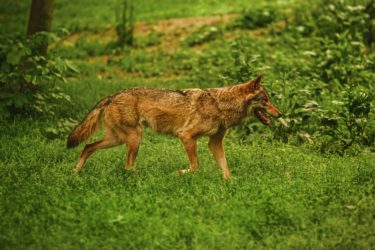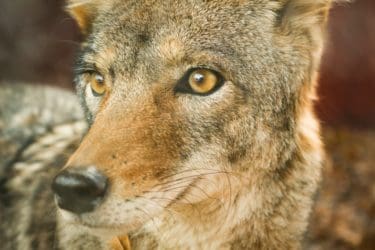call of the wild. eastern coyotes in our neighborhoods.
It’s dusk at Natural Lands’ Gwynedd Preserve. The sun has just dipped below the horizon and the sky is the color of the pinkish-purple Echinacea that dot the preserve’s meadows. Preserve Manager Tom Kershner, who lives on the 279-acre nature preserve, is just sitting down to supper when he hears the now-familiar sound: a high-pitched keening followed by a staccato of gruff barks… the unmistakable call of a coyote.
 “It’s both beautiful and spooky at the same time,” Tom says. “It’s a reminder of how much is going on out there in nature after we humans turn off the lights and go to bed.”
“It’s both beautiful and spooky at the same time,” Tom says. “It’s a reminder of how much is going on out there in nature after we humans turn off the lights and go to bed.”
Popular culture is full of myths and mystery about these wild animals, but the fact of the matter is that coyotes—once only associated with the prairies and mountains of the western part of the U.S.—are now living alongside us in every state in the country.
here, there, and everywhere.
Eastern coyotes (Canis latrans “var”) have been documented in Pennsylvania since the late 1930s. How they got here—or whether they were here all along—is the missing link to the coyote story. Some biologists believe coyotes have always been a part of Pennsylvania’s wildlife community. Others believe western coyotes migrated north into Canada, bred with gray wolves, and the resulting hybrid species moved south into New England and New York and, eventually, Pennsylvania. Despite popular belief, they were not introduced to our area by the Game Commission.

The eastern expansion of the coyote may have been a result of the elimination of its ancient foe, the timber wolf, and growing populations of white-tailed deer, an ample source of food. “Aristotle once said, ‘Nature abhors a vacuum,’” offered Tim Burris, Natural Lands’ wildlife management coordinator and preserve manager of Mariton Wildlife Sanctuary, located in Easton, PA. “If there’s a gap in the ecosystem, sooner or later something’s going to fill it.”
What we do know is that coyote populations have been climbing steadily in recent decades and now outnumber those of black bear, bobcat, and river otter. The range of these animals has expanded as well. Once limited to the rural northern portion of the state, coyotes are becoming as common in Pennsylvania’s suburbs as raccoons, skunks, and groundhogs. Coyotes are believed to be present in every township in the Commonwealth.
heard but not seen.
Despite their robust populations, it’s still somewhat unusual to spot a coyote. This secretive canine prefers to operate under the cover of darkness—unlike its western counterpart—when there are fewer encounters with people. Keen observers may notice their scat or tracks. More frequently, coyotes make their presence known with their vocalizations, which appear to be used primarily to stake out territory and communicate with the pack. In God’s Dog: The North American Coyote, author and naturalist Hope Ryden chronicled her observations of an adult coyote that seemed to be teaching her pups how to howl… the adult singing at a certain octave, the pups trying to mimic, the lesson being repeated over and over. At least 11 different kinds of vocalization have been documented, including woofs, barks, yips, growls, yelps, lone howls, group howls, greeting songs, and group yip-howls.
“I do get calls from neighbors of the preserve from time to time,” said Kershner. “They hear the howls and want to know what the heck is making those eerie sounds.”
fast food.
Coyotes are predatory opportunists: they’ll eat almost anything and prefer to do so with no more effort than is necessary. A good percentage of their diet is made up of mice, voles, and other rodents. During summer and into fall, they’ll feed on berries, insects, field corn, and even acorns. In winter, coyotes rely more heavily on carrion—often deer struck and killed by vehicles. In times of greater need—like when feeding their young—they will go to greater lengths, sometimes entering barnyards and backyards, parks and parking lots, in their quest for food. They will rummage through garbage and consume food left out for pets. Coyotes can and will kill healthy deer. Though still relatively uncommon, they may also prey on cats and small dogs.
The eastern coyote is one of Pennsylvania’s largest predatory animals, second only to the black bear. Yet there has been only one recorded attack on a human in more than 30 years; suggesting that coyotes prefer to avoid close encounters with people. However, they can be territorial around den sites during springtime as they forage almost constantly to provide food for their young.
“They are in the backyard and people don’t know it,” state wildlife conservation officer Jerry Czech recently told the Philadelphia Inquirer. “But people have to understand, these animals don’t hide behind rocks waiting for little Johnny to come out on the playground… They don’t eat people.”
losing ground.
Suburban sprawl has impacted all native wildlife. As habitats are developed and taken over by humans, many species struggle for survival. Some have even become extinct. Others, the eastern coyote among them, have found ways to adapt and even thrive. As coyote numbers have increased, the Pennsylvania Game Commission has responded by liberalizing hunting regulations. Currently, coyotes can be hunted year-round with few exceptions and there are no limits to the size or number that hunters may kill.
What will happen next with Pennsylvania’s coyotes is unclear. But if the state follows the trends unfolding in others nearby, it stands to reason that we’ll be seeing—and hearing—more and more of coyotes.
“This kind of intersection between people and wildlife is just another reminder of how the work of Natural Lands and other conservation organizations is essential… to people and wildlife,” said Oliver Bass, president of Natural Lands. “Saving land means saving habitat. Our ongoing care of these diverse habitats on our 43 properties helps to ensure ecological balance and harmony.”
